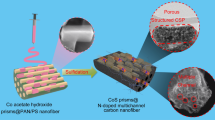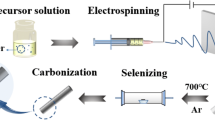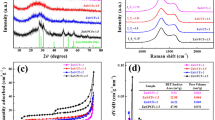Abstract
The pulverization of Sn-based electrode materials, caused by the large volume effect during the charging/discharging process, seriously affects their battery life. Compounding electrospun carbon fibers with a porous structure is an effective means of solving this problem. In this work, porous carbon nanofibers (PCNFs) containing Sn and tin antimonide (SnSb) alloy nanoparticles are prepared by electrospinning using self-made highly dispersed Sb–SnO2 (denoted as antimony-doped tin oxide) wet gel as the precursor of Sn and Sb and polyacrylonitrile (PAN) and polyvinylpyrrolidone (PVP) as the carbon sources. The porous structure is constructed using the difference in solubility in water between PAN and PVP. The results indicate that the as-fabricated PCNFs have a large number of pore structures and an even distribution of Sn and SnSb alloy nanoparticles, which are conducive to an increase in the content of Sn–SnSb electrode active materials. The porous structure both increases the specific surface area of the electrode material and effectively alleviates volume change. Therefore, the as-fabricated Sn–SnSb/PCNFs exhibit high specific capacities and outstanding rate performance and cycling retention, delivering specific capacities of 922 mAh g−1 and 266 mAh g at 50 mA g−1 and 5 A g−1, respectively, as well as a high cycle stability (71%) for 600 cycles at 1 A g−1. This demonstrates their potential application as anode materials in high-energy-density lithium-ion batteries.










Similar content being viewed by others
References
Hu Y, Yang QR, Ma J (2015) Sn/SnO2@C composite nanofibers as advanced anode for lithium-ion batteries. Electrochim Acta 186:271–276
Im HS, Yong JC, Lim YR, Chan SJ, Dong MJ (2013) Phase evolution of tin nanocrystals in lithium ion batteries. ACS Nano 7:11103–11111
Zhang WJ (2011) A review of the electrochemical performance of alloy anodes for lithium-ion batteries. J Power Sources 196:13–24
Derrien G, Hassoun J, Panero S, Scrosati B (2007) Nanostructured Sn-C composite as an advanced anode material in high-performance lithium-ion batteries. Adv Mater 19:2336–2340
Xu ZL, Zhang B, Kim JK (2014) Electrospun carbon nanofiber anodes containing monodispersed Si nanoparticles and graphene oxide with exceptional high rate capacities. Nano Energy 6:27–35
Zou Y, Wang Y (2011) Sn@CNT nanostructures rooted in graphene with high and fast Li-storage capacities. ACS Nano 5:8108–8114
Zhang CL, Yu SH (2014) Nanoparticles meet electrospinning: recent advances and future prospects. Chem Soc Rev 43:4423–4448
Li ST, Wang Z, Liu J, Yang L, Guo Y (2016) Yolk-shell Sn@C eggette-like nanostructure: application in lithium-ion and sodium-ion batteries. ACS Appl Mater Interfaces 8:19438–19445
Zhou X, Dai Z, Liu S, BaoJ Guo YG (2014) Ultra-uniform SnOx/carbon nanohybrids toward advanced lithium-ion battery anodes. Adv Mater 26:3943–3949
Zhao H, Yin C, Guo H (2007) Studies of the electrochemical performance of Sn–Sb alloy prepared by solid-state reduction. J Power Sources 174:916–920
Fan L, Zhang J, Zhu Y, Zhu X, Liang J (2014) Comparison between SnSb-C and Sn-C composites as anode materials for lithium-ion batteries. RSC Adv 4:62301–62307
Besenhard JO, Yang J, Winter M (1997) Will advanced lithium-alloy anodes have a chance in lithium-ion batteries. J Power Sources 68:87–90
Sengupta S, Patra A, Akhtar M, Das K, Majumder SB (2017) 3D microporous Sn–Sb–Ni alloy impregnated Ni foam as high-performance negative electrode for lithium-ion batteries. J Alloys Comp 705:290–300
Xu J, Zhang L, Xu G, Sun Z, Zhang C (2018) Facile synthesis of NiS anchored carbon nanofibers for high-performance supercapacitors. Appl Surf Sci 434:112–119
Xie W, Jiang X, Qin T (2017) Inner porous carbon nanofibers as binder-free electrodes for high-rate supercapacitors. Electrochim Acta 258:1064–1071
Cherian CT, Sundaramurthy J, Reddy MV (2013) Morphologically robust NiFe2O4 nanofibers as high capacity Li-ion battery anode material. ACS Appl Mater Interfaces 5:9957–9963
Yang X, Teng D, Liu B, Yu Y (2011) Nanosized anatase titanium dioxide loaded porous carbon nanofiber webs as anode materials for lithium-ion batteries. Electrochem Commun 13:1098–1101
Ji L, Zhang X (2009) Fabrication of porous carbon/Si composite nanofibers as high-capacity battery electrodes. Electrochem Commun 11:1146–1149
Li Z, Zhang JW, Yu LG, Zhang JW (2017) Electrospun porous nanofibers for electrochemical energy storage. J Mater Sci 52:6173–6195. doi: https://doi.org/10.1007/s10853-017-0794-2
Lv B, Li P, Liu Y (2017) Nitrogen and phosphorus co-doped carbon hollow spheres derived from polypyrrole for high-performance supercapacitor electrodes. Appl Surf Sci 437:169–175
Jo E, Yeo J, Kim DK (2014) Preparation of well controlled porous carbon nanofiber materials by varying the compatibility of polymer blends. Polym Int 63:1471–1477
Li Z, Zhang JW, Shu J, Chen JP, Gong CH, Guo JH, Yu LG, Zhang JW (2018) Carbon nanofibers with highly dispersed tin and tin antimonide nanoparticles: preparation via electrospinning and application as the anode materials for lithium-ion batteries. J Power Sources 381:1–7
Xu Y, Liu Q, Zhu Y (2013) Uniform nano-Sn/C composite anodes for lithium ion batteries. Nano Lett 13:470–474
Cevher O, Guler MO, Tocoglu U (2014) Electrochemical performance of SnO2:Sb-MWCNT nanocomposites for Li-ion batteries. Int J Energ Res 38:499–508
Agubra VA, Zuniga L, Flores D (2017) A comparative study on the performance of binary SnO2/NiO/C and Sn/C composite nanofibers as alternative anode materials for lithium ion batteries. Electrochim Acta 224:608–621
Zhao H, Qi W, Li X (2016) SnSb/TiO2/C nanocomposite fabricated by high energy ball milling for high-performance lithium-ion batteries. RSC Adv 6:32462–32466
Hwang SM, Lim YG, Kim JG (2014) A case study on fibrous porous SnO2 anode for robust, high-capacity lithium-ion batteries. Nano Energy 10:53–62
Acknowledgements
The authors acknowledge funding from the Natural Science Foundation of Henan Province (162300410023) and the National Natural Science Foundation of China (Grant No. 21671057, 21271063, U1704253).
Author information
Authors and Affiliations
Corresponding authors
Additional information
Publisher's Note
Springer Nature remains neutral with regard to jurisdictional claims in published maps and institutional affiliations.
Rights and permissions
About this article
Cite this article
Li, Z., Yin, Q., Hu, W. et al. Tin/tin antimonide alloy nanoparticles embedded in electrospun porous carbon fibers as anode materials for lithium-ion batteries. J Mater Sci 54, 9025–9033 (2019). https://doi.org/10.1007/s10853-019-03539-z
Received:
Accepted:
Published:
Issue Date:
DOI: https://doi.org/10.1007/s10853-019-03539-z




